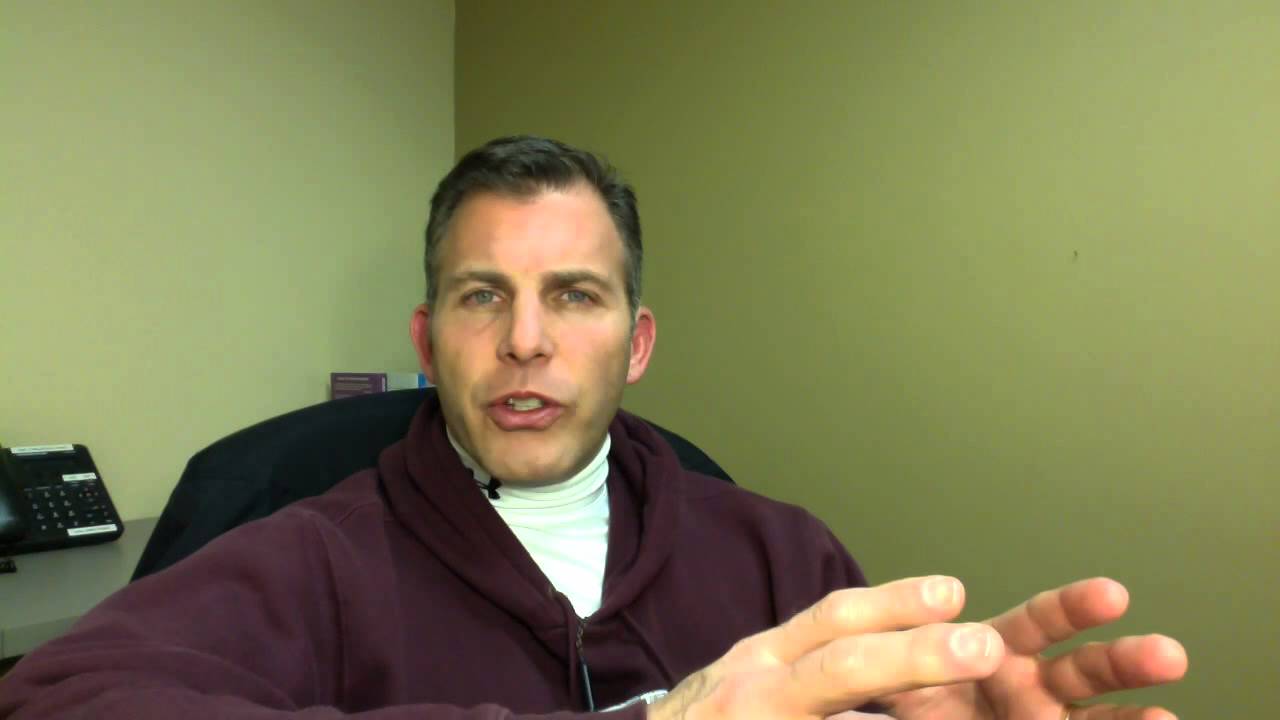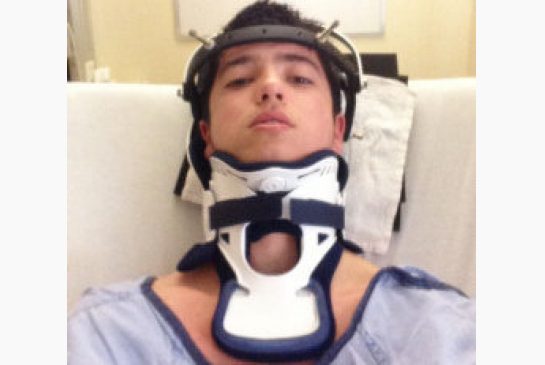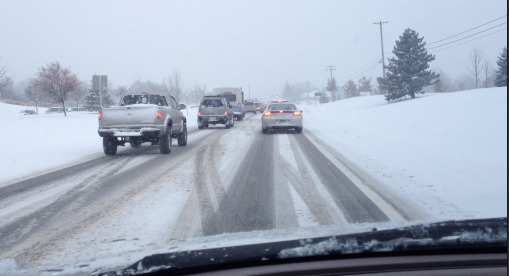In this episode of RoyOnRescue, I answer a question from someone who jumped feet first into a shallow pool and now their foot hurts when they walk on it. Is it broken or just sprained and how do I know what to do? Watch this episode to find out more.
Category Archives: Accidents
How To Survive A Multi-Car Pile Up
Hello Rescue Fans!
In this episode, we breakdown a real situation that occurred this year where over 122 cars were involved in a multi-car pile up that resulted in 1 fatality and 22 others going to the hospital. How would you survive this situation and is there something you can do to ensure you have a better chance to make it out alive? You may want to watch this video today!

How Do I Treat Neck Injuries On The Ice?
In this episode we answer a question that was sent in by a Rescue Fan that wondered what the best course of action would be if a person suffered a neck injury on the ice. It’s important to remember that if the patient has any pain, movement minimization is the goal while maintaining the patients core body temperature while waiting for EMS to arrive. If the person doesn’t feel hurt, they may elect to slowly get to their feet and recover. If they do feel pain, numbness, tingling, weakness or loss of consciousness, the best course of treatment  in my opinion is to call 911 or EMS. I hope it helps.
in my opinion is to call 911 or EMS. I hope it helps.
How To Survive Icy Driving Conditions and Crashes
In this episode I revisit an annual subject that can never be taken too lightly. Safe driving in winter snow and ice. Too many times people follow too closely and don’t leave enough room to evade a crash or to stop at an intersection. If you want to be prepared to survive this winter’s icy driving, be sure to watch this episode of RoyOnRescue and learn what RoyOnRescue is preparing for the new year!
Professional Rescuers and Good Samaritan Act Part 2
I had a royonrescue.com reader who had a concern that the post about the Good Samaritan Act might scare rescuers into not providing care while off duty. I think this may have been a misunderstanding and I must clarify that I’m speaking to medical professionals that have training and expertise in the area of rescue, not those volunteers, family members, bystanders without any training who may want to try and get involved. Below is the comment from this individual and my response back to them with references. I hope this helps anyone else who may have had the same concern or question.
Question/Comment: 4-3-11
Dear Mr. Shaw,
I found your video, Professional Rescuers and The Good Samaritan Law, discouraging. I agree with just about everything you advised, but I have one major complaint. You said, “You can do care up to a specific level. In fact, that of which you are trained to do proficiently.” I think what you have said is misleading.
If you apply those restrictions to Good Samaritan laws, you defeat the intent of those laws*. Here’s a quick example: I would guess that 90% of civilians who have taken CRP classes (as I have) are not proficient in CPR. They have a good idea what CPR is, but in an emergency with the adrenalin flowing, I can see them making numerous missteps, which may or may not affect the outcome. According to your advice even a Red Cross card carrying volunteer should not attempt CPR because he/she is not proficient. And what about the AEDs appearing in malls and schools? According to your advice, the average passer-by who’s had no training should only call 9-1-1 and leave this new fangled equipment for the experts! I’m sure that is not what you would advise.
Then, there is the example of your buddy, the snowmobiler, with the crushed & torn larynx. It sounds like you let him die? You knew what needed to be done, a surgical tracheotomy. Of course your snowy scene was “an uncontrolled environment”. Isn’t that’s why it’s an “emergency”. You had the equipment and you had the training, but you chose not to do that which you could do. Personally, I think you should have at tried. (Jas 4:17) Sure, like you said, the scene was far from perfect but you had what you needed to perform the procedure. And yes, you may be right, there’s a good chance you would not have been successful. But if your friend could have, don’t you think he or his wife would have wanted you to at least try?
Instead of encouraging guys like me to do what they reasonable can, you’ve lead us to believe we need to be trained or we will be held liable for trying. The best way to ensure that one follows your advice to “Do No Further Harm” is to look the other way.
FYI: I carry Celox & QuikClot, which I know state protocols does not allow EMTs and medical professionals use. I’ve never used it nor been trained, but if on the firing range someone gets shot and I have no other means to stop a bleed out, I intend to try it. Hopefully, I will never be put to the test on the highway or the rifle range, but despite your warning about “level of training” and “proficiency” it is an option I may have to pick.
Despite my disapproval of this video, I have check out some of your other stuff and I think you do a pretty good job, esp. your written responses (unlike mine).
Thanks for sharing
My Response:
Hello “Name Not Disclosed” ,
I appreciate you taking the time to respond to the royonrescue.com blog entry, “Professional Rescuers and The Good Samaritan Law”.
I wanted to clarify the “providing care up to ones level of trained proficiency”.
The Good Samaritan Act in the State of Michigan states;
“691.1501 Physicians, physician’s assistant, or nurses rendering emergency care or determining fitness to engage in competitive sports; liability for acts or omissions; definitions.
(1) A physician, physician’s assistant, registered professional nurse, or licensed practical nurse who in good faith renders emergency care without compensation at the scene of an emergency, if a physician-patient relationship, physician’s assistant-patient relationship, registered professional nurse-patient relationship, or licensed practical nurse-patient relationship did not exist before the emergency, is not liable for civil damages as a result of acts or omissions by the physician, physician’s assistant, registered professional nurse, or licensed practical nurse in rendering the emergency care, except acts or omissions amounting to gross negligence or willful and wanton misconduct.
(2) A physician or physician’s assistant who in good faith performs a physical examination without compensation upon an individual to determine the individual’s fitness to engage in competitive sports and who has obtained a form described in this subsection signed by the individual or, if the individual is a minor, by the parent or guardian of the minor, is not liable for civil damages as a result of acts or omissions by the physician or physician’s assistant in performing the physical examination, except acts or omissions amounting to gross negligence or willful and wanton misconduct or which are outside the scope of the license held by the physician or physician’s assistant. The form required by this subsection shall contain a statement indicating that the person signing the form knows that the physician or physician’s assistant is not necessarily performing a complete physical examination and is not liable under this section for civil damages as a result of acts or omissions by the physician or physician’s assistant in performing the physical examination, except acts or omissions amounting to gross negligence or willful and wanton misconduct or which are outside the scope of the license held by the physician or physician’s assistant.
(3) A physician, physician’s assistant, registered professional nurse, or licensed practical nurse who in good faith renders emergency care without compensation to an individual requiring emergency care as a result of having engaged in competitive sports is not liable for civil damages as a result of acts or omissions by the physician, physician’s assistant, registered professional nurse, or licensed practical nurse in rendering the emergency care, except acts or omissions amounting to gross negligence or willful and wanton misconduct and except acts or omissions that are outside the scope of the license held by the physician, physician’s assistant, registered professional nurse, or licensed practical nurse. This subsection applies to the rendering of emergency care to a minor even if the physician, physician’s assistant, registered professional nurse, or licensed practical nurse does not obtain the consent of the parent or guardian of the minor before the emergency care is rendered”. http://nspc203.com/leg/MichiganGoodSamaritanActForMedicalProfessionals.htm
And in one other source I found an explanation that goes on to describe the Good Samaritan Act this way; “While Good Samaritan laws vary from state to state, these laws typically apply when you take purely voluntary, good-faith action to help another person at the scene of an emergency, and the person does not object to your help. If you provide help to another person under a Good Samaritan law, keep in mind that you must exercise the same standard of care and/or treatment that you normally help to in your profession. In other words, if you’re a trained medical professional, then you must act according to medical professional standards. However, if you are not trained in a medical professional, then your duty may be only to call for help or other forms of help, but not to render medical care or first aid. So long as you act reasonably in light of the circumstance, and in keeping with professional standards, you probably will not be liable in a jurisdiction that has enacted a Good Samaritan law”.
http://resources.lawinfo.com/en/Articles/personal-injury/Federal/what-are-good-samaritan-laws.html
So you see, this is why no matter how much I would like to re-assure professionals that they are completely safe when rendering aid and especially “creative solutions medicine” to a person without repayment as a Good Samaritan, the professional still needs to understand that because of their training, they do have a duty to perform to a “standard of care” appropriate for their profession even if it’s frustrating and they may think that they can do more.
Individuals who offer Good Samaritan aid and have never been trained in any medical area may not be held to the same standards if they are sued, but the original blog was directed toward those with training and professional expertise in the area of rescue which is a different scenario.
I hope this helps to clear up any misunderstanding or confusion and please don’t hesitate to contact me for more clarification or for any future subjects down the road.
Best Wishes,
Roy Shaw, RoyOnRescue.com
royonrescue@gmail.com
Concussion vs. Closed Head Injury
Ever see someone hit their head very hard? Wonder if it’s just a minor “Knock on the Noggin” or could it be a serious head injury? In this Roy On Rescue Video Blog entry, Roy Shaw, EMT-Paramedic answers those questions with directives on how to assess, stabilize and treat a person for a serious head injury or minor. There’s nothing worse than sitting with a crying child or an injured adult and wonder if we are over reacting by calling 911, or under reacting by not doing more. Watch this video blog for some interesting insights straight from the Paramedics mouth on what to do.
Don’t miss this entry where Roy puts a common sense spin on how to handle the next event where someone hits their head and no one knows if they should go in to the hospital or just sleep off the headache.
Watch the video below if you would like to see a video animation of what happens in the skull when a person hits their head.
A website that shows a video explaining a traumatic closed head injury is located at: http://www.youtube.com/watch?v=AmAML1-F2LE
What To Do If A Person Falls and Hits Their Head
A concerned Good Samaritan(G.S.) wrote me a question and I thought it would be good to share it with you on RoyOnRescue(ROR).
G.S.: “In my scenario, the person fell down hit their head twice and then fell onto the floor face down. I am now wondering if we did the right thing. We picked the person up and carried her outside for fresh air where she revived immediately. We then monitored the person but nothing else seemed to be wrong with her.”
ROR: It sounds like the story ends well regardless of the treatment given which is always great! There may be a few things that we cold improve upon for the future. Let’s analyze what happened and what we might be able to do differently next time to protect and help the fall victim even more.
Whenever a person falls, there is a risk for head and neck injury. As stated in your scenario, this particular person did hit their head… twice. This would be enough mechanism of injury that instead of moving the person right away, we would want to minimize movement while assessing the person for any signs or symptoms of other injuries. We can minimize movement by softly but confidently speaking to the patient who is either conscious or unconscious and place one hand carefully on the victims forehead to help remind them and us not to move their head and neck. Try to find out if the person is breathing on their own and if their skin color is somewhat normal while they are lying in the position found. If they are breathing and skin color is good, we do not have to move the person before Emergency Medical Services arrive.
If assessing the person’s airway is impossible in this position,(face down) we may need to carefully roll the person over onto their back even if we suspect that there may be a serious neck or back injury. We do not move spinal chord injury patients unless they need cpr, their airway is compromised or they are in danger due to the environment.
If we determine that we must roll, or move a person with a suspected spinal chord injury, utilize several people if available, in order to minimization spinal movement. If you are the only person, then do the job the best way you can and follow the “Life Over Limb” philosophy. If the person wakes and is not complaining of any pain or numbness and they don’t allow you to minimize movement because they want to get up, they should be allowed to do so. It is not wise to hold the person down as this can complicate injuries the patient already sustained trying to wrestle. Keep encouraging the person to stay still until help arrives by the ambulance service. Keep the person in a position of comfort with confident words of encouragement like, you are in good hands, I’m going to take good care of you and help is on the way. If they still refuse treatment, there is little you can do at that point other than inform 911 of what has happened.
It sounds as though you did the best you could for this person at the time. Remember, most people don’t even get involved when someone needs help. The fact that you did get involved and tried to help makes you a natural rescuer!
I thought a video clip of all different fainting episodes would not only get my point across that falls can cause injuries to the person even if the fainting spell or the reason they fell wasn’t serious. I hope you don’t feel faint watching others faint but if you want to see what happens to people when they fall from standing up, take a look at the clip below.
P.S. One of the most effective rescue moves for a person who is starting to faint, is to simply help them to the floor before they fall!
Best Wishes,
Roy On Rescue



